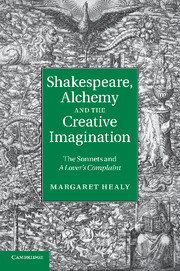Book contents
- Frontmatter
- Contents
- List of illustrations
- Acknowledgements
- A note on the texts
- Introduction
- 1 Alchemical contexts
- 2 Lovely boy
- 3 The dark mistress and the art of blackness
- 4 A Lovers Complaint by William Shake-speare
- 5 Inner looking, alchemy and the creative imagination
- 6 Conclusion: Shakespeare's poetics of love and religious toleration
- Notes
- Index
3 - The dark mistress and the art of blackness
Published online by Cambridge University Press: 18 December 2013
- Frontmatter
- Contents
- List of illustrations
- Acknowledgements
- A note on the texts
- Introduction
- 1 Alchemical contexts
- 2 Lovely boy
- 3 The dark mistress and the art of blackness
- 4 A Lovers Complaint by William Shake-speare
- 5 Inner looking, alchemy and the creative imagination
- 6 Conclusion: Shakespeare's poetics of love and religious toleration
- Notes
- Index
Summary
PART I IN PRAISE OF BLACKNESS
In the old age black was not counted fair,
Or if it were it bore not beauty's name;
But now is black beauty's successive heir.
(Sonnet 127, 1–3)Thy black is fairest in my judgement's place.
(Sonnet 131, 12)When nature made her chief work, Stella's eyes,
In colour black why wrapped she beams so bright?
(Sidney, Astrophil and Stella. 7, 1–2)Shakespeare's enigmatic dark lady makes her abrupt entrance in Sonnet 127, immediately compelling the question, why is she ‘black’? This is, of course, a witty strategy, ‘cocking a snook’ at Petrarchan norms and allowing the poet to demonstrate his considerable prowess, subverting the usual blazon with ‘dun’ breasts and ‘black wires’ (Sonnet 130, 3, 4) and shaping novel beauty in his lines. In his fashioning of Stella's hybrid black and white excellence, Sidney had dipped his toes into these dusky female waters somewhat before, inaugurating a tradition of poetic play around a black–white dichotomy. In her seminal study, Things of Darkness, Kim Hall has argued that the latter preoccupation was a direct consequence of ‘concerns’ and ‘fears’ bred by ‘increased travel abroad’ and ‘colonial/imperial encounters with the twin otherness of culture and gender’. In Hall's reading, cultural anxieties about racial difference and miscegenation were subdued or even effaced through the mediation of a textual poetics that rendered black women ‘fair’, and also by visual artefacts like the fashionable jewelled miniatures bearing sardonyx busts of black ladies.
- Type
- Chapter
- Information
- Shakespeare, Alchemy and the Creative ImaginationThe Sonnets and A Lover's Complaint, pp. 98 - 130Publisher: Cambridge University PressPrint publication year: 2011



